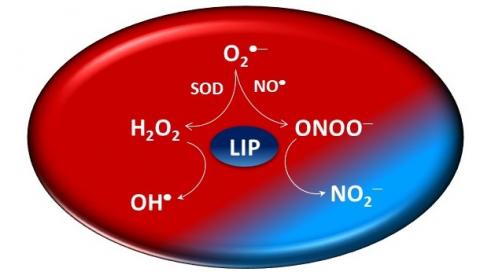The interaction between peroxides and the labile iron pool: a new side of the coin

The redox iron-fist of cells may not always be so harsh, this study suggests.
Redoxoma Highlights by José Carlos Toledo Jr.
Every cell keeps low levels of an iron source called the Labile Iron Pool (LIP), which serves primarily as a reservoir of iron to be loaded into apo iron-proteins. LIP iron is probably weakly bound to proteins and small molecules, but its precise nature and cellular location are not yet known. LIP quantity varies among different cell types and is tightly regulated by complex homeostatic mechanisms, deregulation of which can be dangerous. For instance, aberrant accumulation of LIP is a hallmark of cardiovascular diseases and neurological disorders. Although still not clear, it is widely accepted that, upon a reaction with the ubiquitous hydrogen peroxide, LIP facilitates the production of highly reactive species that oxidize proteins, DNA and membrane lipids, and that these damages contribute to multiple pathologic conditions. In agreement, in vitro, iron reduces hydrogen peroxide to the hydroxyl radical, a very reactive oxidant species. From this perspective, it makes sense that normal cells keep low levels of LIP, which presumably minimizes production of oxidants. However, our recent finding suggests there is another side of this story. It was recently found that LIP reacts with a peroxide called peroxynitrite, a toxic oxidant that is formed in cells, and thereby actually decreases peroxynitrite-dependent oxidation of an intracellular indicator. This observation may change the widespread notion that the LIP is solely a cellular pro-oxidant iron source and provides additional information to understand biological phenomena in conditions where peroxynitrite and LIP overlap.
Related article:
- F. C. Damasceno, A. L. Condeles, A. K. B. Lopes, R. R. Facci, E. Linares, D. R. Truzzi, O. Augusto, J. C. Toledo. The labile iron pool attenuates peroxynitrite-dependent damage and can no longer be considered solely a pro-oxidative cellular iron source Journal of Biological Chemistry, 293(22): 8530–42, 2018 | doi: 10.1074/jbc.ra117.000883
José Carlos Toledo Jr., PhD. Professor at Department of Chemistry,
Faculdade de Filosofia, Ciências e Letras de Ribeirão Preto, University of São Paulo, Brazil
Add new comment